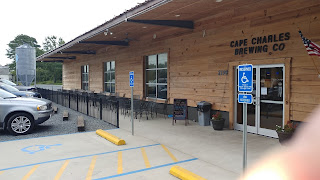Time: 10:15 - 11:45 am
Air temps: upper 50s to low 60s
Skies: partly cloudy
Water temps: low 60s
Pattern: Hopper with a Rainbow Warrior dropper
I started at the abandoned beaver condo down from the lower hole. Although there were a few holding spots, I didn't see a fish until I got up to the lower hole behind the tavern The big Golden has been hanging out there all summer. While he normally holds in deeper water under a sunken log on the left side of the hole, this morning he was stationed in the shallower water on the right side. I made a few casts into the run, and saw a flash, then made a few casts to the Golden. Amazingly, he ate the Rainbow Warrior.
The Golden, which easily went 18-20 inches, tore up my Rainbow Warrior, so I tied on a 16 Pheasant Tail nymph, and decided to stick around the lower hole for a while longer to make sure the Golden was okay. A few more casts into the upper riffle and I hooked up to a nice little wild Brownie.
There wasn't much in the way of good holding water, so I got out and moved up to the pool at Camp Bearclaw. My first cast brought a trout up for a look before he headed back down to the deeper water. A few casts later a pretty decent sized creek chub took the fly, and as I was stripping in the chub the trout came up and inhaled the chub. That fight didn't last long, as the trout quickly let go of his meal. But it was obvious that this fish wanted to eat. So I added another foot or so of tippet to the nymph and tied on a Chamois Worm. Next cast and a nicely colored 12 inch Rainbow came to the net.
From the Camp Bearclaw hole up there wasn't much in the way of good holding water, but I did manage this little stream-bred gem in a shallow riffle.
A sign of a pretty healthy stream. Let's hope the little guy gets a few years to turn from prey into predator.
Middle Chesapeake - Capt. DiPaola report:
Time: 0800 - 10:30 am
Air temps: upper 60s to low 70s
Skies: mostly sunny
Water temps: 80.2
Pattern: live Norfolk spot
A few storms Thursday night broke a hot and humid pattern in Chesapeake country. The boat looked tired of sitting in the slip and with a light westerly breeze, I thought I would try some late summer live-lining for stripers.
The light westerly breeze blew more from the north as I turned out of Whitehall Bay with 2 - 3' rollers. I was easily distracted however by large numbers of birds to the south. I was able to relieve my addiction to the frenetic surface action when every cast hooked a 10" fish.
Recent reports indicated large fish caught with spot in the Chester river, but with a pretty decent chop I thought I would try to find some keepers near the Bay Bridge pilings. Our usual spots were taken by charters and weekend warriors. With the wind and waves, I thought that it would be better to find some open area to work. I headed back to the western side of the bay to get leeward of the wind and find some drop-offs. On the north span, there was a protected cove in the wake of a bridge stanchion. Since I was solo, this quiet locale enabled me to keep my position with little effort. Even better, I was marking a lot of fish down to 25'.
The tide was barely running so I added weight to the leader (see our late July post on the benefits of weighted live-lining!), and I was quickly rewarded with two abrupt tugs and a strong pull on the line. I hooked a nice 20" keeper with a perfect hook set. He will make for some nice table fare.
Nice to know that whether fishing North or South, Mikey D Fishing can score during the dog days of August!
Tight Lines,
Mikey D. Fishing




























